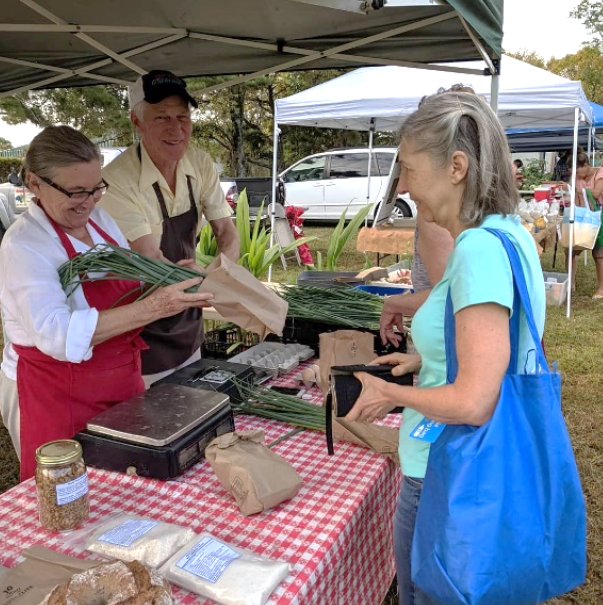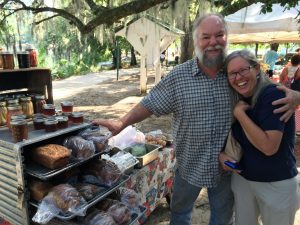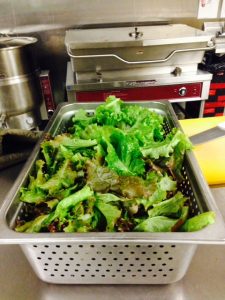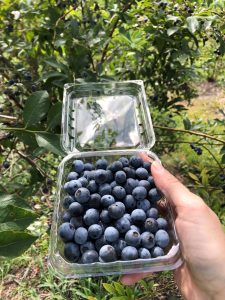
Farmers markets give customers the opportunity to discover seasonal products and meet the growers behind their food. Photo by The Tallahassee Farmers Market.
Choosing where to sell your farm products can feel a little like planting a fruit tree – it takes effort to get established, not everything will thrive in your soil, and ideally, it’s something you’ll be glad you planted years down the road. In the Florida Panhandle, we’re lucky to have a diverse food-loving community, but that doesn’t mean every direct-to-consumer (DTC) model is the right fit for every grower. Whether you’re just getting started or thinking about shifting your approach, it helps to weigh the pros, cons, and quirks of each outlet – farmers markets, Community Supported Agriculture (CSA), restaurant sales, or a mix of models – before diving in.
–
Farmer’s Markets: The Community Hub

Farmers markets offer vendors a chance to connect with customers, showcase fresh, local products, and build community relationships face-to-face. Photo by Molly Jameson.
Selling at a farmer’s market gives you direct access to customers who are already looking to buy fresh, local products. These markets often have loyal followings and give you a chance to build name recognition and collect useful feedback face-to-face with potential customers.
Good fit if you:
- Enjoy interacting with customers
– - Want to build a strong community presence
– - Can commit to transportation, set up times, and regular market hours
– - Have products that look good displayed and can move quickly
–
Things to consider:
Markets often require early mornings, setup labor, and vendor fees. Weather, competing vendors, and market day traffic levels can all affect your sales. It takes time to develop a following, so don’t be discouraged by a slow start.
Helpful resources:
- The Florida Farmers’ Market Association: A statewide organization that supports farmers markets, vendors, and managers with training, networking, and practical resources. It’s a great place to find nearby markets and pick up tips for boosting your booth and sales.
– - UF/IFAS Farmers’ Market Checklist: A helpful planning tool to guide farmers through what to bring, how to prepare, and how to present your products at a farmers market – perfect for beginners or seasoned vendors looking to fine-tune their setup.
– - Community Farmers Markets: The Florida Department of Agriculture and Consumer Services (FDACS) maintains a directory of community farmers markets across the state.
–
CSA: Loyal Customers, Seasonal Surprises

A CSA share highlights the variety and freshness customers receive each week, while providing farmers with steady support and a reliable market. Photo by Red Hills Small Farm Alliance.
Community supported agriculture (CSA) models offer upfront financial support from customers in exchange for a weekly box of whatever is in season. In theory, this reduces risk for farmers and builds a loyal customer base. In reality, it requires serious planning, good communication, and a steady harvest schedule.
Good fit if you:
- Are organized, reliable, and can commit to a consistent delivery schedule
– - Grow a wide variety of produce with multiple harvest periods
– - Enjoy building close relationships with customers
– - Don’t mind the occasional email asking why there’s no lettuce in August
–
Things to consider:
Customers expect variety and volume. A few bad weeks, due to weather or pests, can put a dent in trust, so it helps to over-plant a little and be transparent when things don’t go as planned.
Helpful resources:
- Community Supported Agriculture – ATTRA Sustainable Agriculture Program: This guide walks you through the ins and outs of launching a CSA program, from crop planning and pricing to member communication and delivery logistics.
– - UF/IFAS: Community Supported Agriculture: This page covers the essentials of running a CSA, including crop scheduling, share size options, marketing tips, and managing member expectations.
–
Restaurant Sales: Selling Direct to Chefs

Supplying restaurants with fresh, high-quality ingredients – like these locally grown greens – can be a rewarding outlet for farmers who can harvest to order and maintain consistent quality. Photo by Laurie Jones.
Restaurants can be a great fit for specialty crops and high-quality ingredients. If you’re growing heirloom tomatoes, edible flowers, baby greens, or just have a beautiful product, chefs will often pay a premium for freshness and flavor.
Good fit if you:
- Can harvest to order and maintain consistent quality
– - Are comfortable coordinating directly with chefs
–
Things to consider:
Chefs are always busy, and menus can change overnight. Orders may fluctuate wildly, and payment timelines vary – some pay weekly while others might keep you waiting a full month. It helps to start small, build relationships, and be clear about your minimums and expectations.
Helpful resources:
- Tips for Selling to Restaurants – ATTRA Sustainable Agriculture Program: This guide from ATTRA covers practical ways to market to restaurants – from setting prices and handling deliveries to starting conversations with chefs.
– - Florida MarketMaker: An online platform that connects farmers with buyers – from local restaurants to grocery stores – throughout Florida. Farmers can create a free profile, list products, and find new wholesale or bulk customers.
–
More Ways to Reach Your Customers
CSA, farmers markets, and restaurant sales are three of the most common direct-to-consumer (DTC) models, but other models might better suit your operation or round out your income.
–
On-Farm Sales
Opening your farm to the public can help you sell products on your own terms, build relationships with your local community, and create memorable experiences that keep customers coming back.

Freshly picked blueberries at a U-pick farm – giving customers a hands-on way to harvest seasonal crops while creating memorable farm experiences. Photo by Molly Jameson.
- U-Pick Operations
Letting customers harvest their own berries, flowers, or seasonal crops creates a fun, hands-on experience – and can reduce your harvest labor. Successful U-pick operations require thoughtful planning around access, parking, signage, hand-washing stations, and customer flow. Even if you’re not growing blueberries, this Quick Tips for a Successful U-Pick guide from the Florida Blueberry Growers Association offers helpful, Florida-specific insight on what makes these experiences run smoothly.
– - Farm Stands
A roadside or on-farm stand gives you full control over pricing, hours, and product mix – ideal if you’re on a well-traveled road or have a strong local following. It’s a flexible option for selling fresh produce, surplus, or value-added goods without market fees. Tips for Selling at Roadside Stands offers practical guidance for anyone interested in setting up or refining their farm stand.
– - Agritourism and On-Farm Events
Seasonal events like plant sales, farm tours, harvest festivals, or farm dinners can boost income and visibility. Florida law offers liability protection for agritourism activities if specific signage is posted as outlined in Statute §570.96. Signs with the required language are available from the Florida Agritourism Association.
–
Online Pre-Orders & E-Commerce
Selling through a website or platform lets you take pre-orders and either deliver or arrange local pickup. Customers can choose what they want each week – like a buying club or CSA-style box – just without the fixed contents. While it takes a bit more coordination and planning, many growers find it reduces waste and improves satisfaction.

The Red Hills Online Market lets customers pre-order from multiple local farmers and food producers, with convenient pickup or delivery options. Photo credit: Red Hills Small Farm Alliance.
One local example is the Red Hills Online Market, run by the non-profit Red Hills Small Farm Alliance. Customers shop online Sunday through Tuesday and pick up their orders on Thursdays or have them delivered. It’s a streamlined system that many growers around Tallahassee rely on, offering shared infrastructure and support.
Other DTC options include partnering with local supermarkets or co-ops, working with schools or institutions, offering delivery to workplaces or senior centers, or exploring mobile markets to serve underserved communities. Each offers its own set of challenges and opportunities.
–
So… Which One Should You Choose?
Choosing the right combination depends on your goals, crops, and capacity – but there’s no one-size-fits-all solution. Start where you’re most comfortable, then adapt as your farm grows. Many small farmers in our region use a hybrid approach – like CSA plus a weekly restaurant delivery, or regular market sales with a pop-up farm stand during a heavy harvest window. That flexibility can smooth out the bumps, especially when dealing with unpredictable weather, pests, or life in general. Don’t let perfection hold you back – it’s okay to start small and build over time.
Whatever model you choose, it’s worth asking:
- What do I enjoy doing the most?
– - What do my customers value most?
– - What feels sustainable for my farm and my lifestyle?
– - How do I want to communicate and stay connected with my customers?
–
And don’t forget to cover your bases. Before becoming a farmers market vendor, hosting an event, or selling products online, make sure you’ve checked into local zoning, food safety requirements, signage rules, and sales tax collection. Your local UF/IFAS Extension Office can help you figure out who to contact and what steps to take to stay compliant.
If your marketing strategy fits your lifestyle and values – and you’re legally and logistically prepared – you’re more likely to stick with it (and remain sane in the process).
–
For a broader overview of direct marketing options and value-added products, visit: Direct Marketing and Value-Added – UF/IFAS Small Farms and Alternative Enterprises. If you want a deeper look at pricing, promotion, and building customer relationships, check out the Florida Direct Marketing Handbook from the UF/IFAS Bookstore.
- Choosing the Right Sales Model for Your Small Farm - July 31, 2025
- Specialty Peppers for Every Heat Level - January 31, 2025
- Understanding Short-Day vs. Long-Day Onions - July 26, 2024
